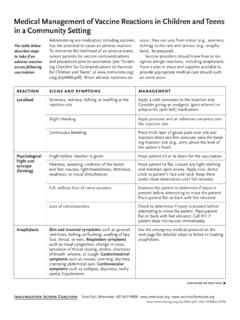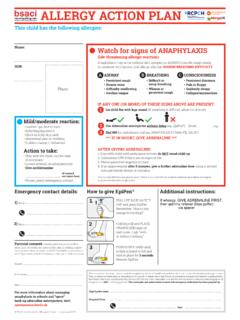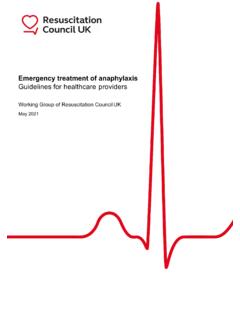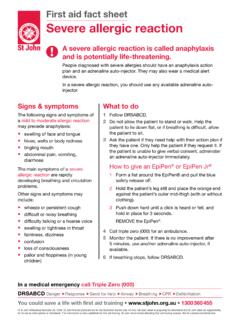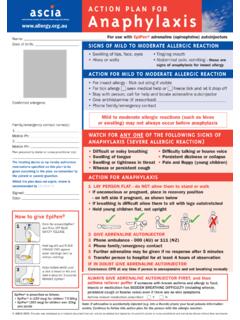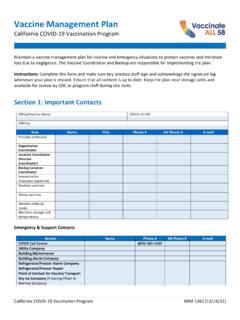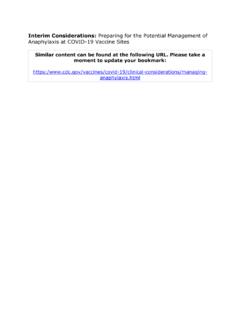Transcription of Acute Management of Anaphylaxis
1 1 Acute Management of Anaphylaxis ASCIA Guidelines for Acute Management of Anaphylaxis (severe allergic reactions) are intended for medical practitioners, nurses and other health professionals who provide first responder emergency care. Appendix A includes additional information for health professionals working in emergency departments, ambulance services, and rural or regional areas, who provide emergency care. Contents 1. Definition and clinical diagnostic criteria for Anaphylaxis 1 2. Signs and symptoms of allergic reactions 2 3. Immediate actions for Anaphylaxis 2 4. Anaphylaxis triggers and reaction times 3 5. Adrenaline (epinephrine) administration and dosages 3 6.
2 Management of Anaphylaxis in pregnancy and infants 4 7. Positioning of patients with Anaphylaxis 4 8. Equipment required for Acute Management of Anaphylaxis 5 9. Supportive Management and additional measures 5 10. Actions after administration of adrenaline 6 Appendix A: Advanced Acute Management of Anaphylaxis 7 Appendix B: Acknowledgements 10 1. Definition and clinical diagnostic criteria for Anaphylaxis ASCIA defines Anaphylaxis as: Any Acute onset illness with typical skin features (urticarial rash or erythema/flushing, and/or angioedema), plus involvement of respiratory and/or cardiovascular and/or persistent severe gastrointestinal symptoms; or Any Acute onset of hypotension or bronchospasm or upper airway obstruction where Anaphylaxis is considered possible, even if typical skin features are not present.
3 The ASCIA definition is consistent with the following criteria published in the World Allergy Organisation Anaphylaxis Guidance Position Paper 2020. Anaphylaxis is highly likely when any one of the following two criteria are fulfilled: Criteria 1. Acute onset of an illness (minutes to several hours) with simultaneous involvement of the skin, mucosal tissue, or both ( generalized hives, pruritus or flushing, swollen lips-tongue-uvula), and at least one of the following: a) Respiratory compromise ( dyspnea, wheeze-bronchospasm, stridor, reduced peak expiratory flow, hypoxemia). b) Reduced blood pressure or associated symptoms of end-organ dysfunction ( hypotonia [collapse], syncope, incontinence).
4 C) Severe gastrointestinal symptoms ( severe crampy abdominal pain, repetitive vomiting), especially after exposure to non-food allergens. Criteria 2. Acute onset of hypotension or bronchospasm or laryngeal involvement after exposure to a known or highly probable allergen for that patient (minutes to several hours), even in the absence of typical skin involvement. ASCIA Guidelines: Acute Management of Anaphylaxis 2 2. Signs and symptoms of allergic reactions Mild or moderate reactions (may not always occur before Anaphylaxis ): Swelling of lips, face, eyes Hives or welts Tingling mouth Abdominal pain, vomiting - these are signs of Anaphylaxis for insect sting or injected drug (medication) allergy Anaphylaxis Indicated by any one of the following signs.
5 Difficult or noisy breathing Swelling of tongue Swelling or tightness in throat Difficulty talking or hoarse voice Wheeze or persistent cough - unlike the cough in asthma, the onset of coughing during Anaphylaxis is usually sudden Persistent dizziness or collapse Pale and floppy (young children) Abdominal pain, vomiting - for insect stings or injected drug (medication) allergy 3. Immediate actions for Anaphylaxis 1. Remove allergen (if still present), stay with person, call for assistance and locate adrenaline injector. 2. LAY PERSON FLAT - do NOT allow them to stand or walk If unconscious or pregnant, place in recovery position - on left side if pregnant, as shown below If breathing is difficult allow them to sit with legs outstretched Hold young children flat, not upright 3.
6 GIVE ADRENALINE INJECTOR Give intramuscular injection (IMI) adrenaline into outer mid-thigh without delay using an adrenaline injector if available OR adrenaline ampoule/syringe. Adrenaline (epinephrine) is the first line treatment for Anaphylaxis . 4. Give oxygen if available. 5. Phone ambulance - 000 (AU) or 111 (NZ) to transport patient if not already in a hospital setting. 6. Phone family/ emergency contact. 7. Further adrenaline may be given if no response after 5 minutes. IF IN DOUBT GIVE ADRENALINE 8. Transfer person to hospital for at least 4 hours of observation. 9. Commence CPR at any time if person is unresponsive and not breathing normally. ALWAYS GIVE ADRENALINE FIRST, then asthma reliever if someone with known asthma and allergy to food, insects or medication has SUDDEN BREATHING DIFFICULTY (including wheeze, persistent cough or hoarse voice) even if there are no skin symptoms.
7 Note: If adrenaline is accidentally injected ( into a thumb) phone your local poisons information centre. Continue to follow this action plan for the person with the allergic reaction. ASCIA Guidelines: Acute Management of Anaphylaxis 3 4. Anaphylaxis triggers and reaction times The most common triggers of Anaphylaxis are foods, insect stings and drugs (medications). Less common triggers include latex, tick bites, exercise (with or without food), cold temperatures, radiocontrast agents, immunisation (rare) and unidentified (idiopathic). Anaphylaxis usually occurs within one to two hours of ingestion in food allergy. The onset of a reaction may occur rapidly (within 30 minutes) or be delayed several hours ( in mammalian meat allergy and food dependent exercise induced Anaphylaxis , where symptoms usually occur during exercise).
8 Anaphylaxis to stings and injected medications (including radiocontrast agents and vaccines) usually occurs within 5-30 minutes but may be delayed. Anaphylaxis to oral medications can also occur but is less common than to injected medications. 5. Adrenaline administration and dosages Adrenaline is the first line treatment for Anaphylaxis and acts to reduce airway mucosal oedema, induce bronchodilation, induce vasoconstriction and increase strength of cardiac contraction. Give INTRAMUSCULAR INJECTION (IMI) OF ADRENALINE (1:1,000) into outer mid-thigh ( per kg up to per dose) without delay using an adrenaline injector if available OR adrenaline ampoule and syringe, as shown in the table below. Adrenaline (epinephrine) dose chart Age (years) Weight (kg) Volume (mL) of adrenaline 1:1,000 ampoules Adrenaline injector devices (for use instead of ampoules) ~<1 < mL Not available ~1-2 10 mL kg (~<5yrs) 150 microgram device ~2-3 15 mL ~4-6 20 mL ~7-10 30 mL >20 kg (~>5yrs) 300 microgram device ~10-12 40 mL >12 and adults >50 mL >50 kg (~>12 years) 300 microgram or 500 microgram device Adrenaline 1:1,000 ampoules contain 1mg adrenaline per 1mL EpiPen Jr and Anapen Junior 150 are examples of 150 microgram ( mg) devices.
9 EpiPen and Anapen 300 are examples of 300 microgram ( mg) devices. Anapen 500 is an example of a 500 microgram ( mg device). The adrenaline injector devices listed above are available in Australia on the Pharmaceutical Benefits Scheme (PBS). Adrenaline injector devices are not yet reimbursed by Pharmac in New Zealand. Adrenaline injector devices are not yet reimbursed by Pharmac in New Zealand. Note: If multiple doses are required to treat Anaphylaxis (2 to 3 doses administered at 5 minute intervals), consider adrenaline infusion if skills and equipment are available. For emergency treatment of Anaphylaxis , ampoules of adrenaline 1:1,000 should be used for both IM doses and infusion if required (adrenaline 1:10,000 should not be used).
10 ASCIA Guidelines: Acute Management of Anaphylaxis 4 6. Management of Anaphylaxis in pregnancy and infants Management of Anaphylaxis in pregnancy Management of Anaphylaxis in pregnant women is the same as for non-pregnant women. Adrenaline should be the first line treatment for Anaphylaxis in pregnancy, and prompt administration of adrenaline (1:1,000 IM adrenaline per kg up to per dose) should not be withheld due to a fear of causing reduced placental perfusion. The left lateral position is recommended, as shown below. For more information go to Management of Anaphylaxis in infants Whilst 10-20kg was the previous weight guide for a adrenaline injector device, a device may now also be prescribed for an infant weighting by health professionals who have made a considered assessment.



